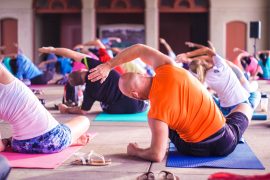This article was originally published in the BMJ Opinion on 21st August 2019.
New research shows that any level of movement decreases risk of premature death, so get moving say Ulf Ekelund and Thomas Yates
 It is well established that physical activity of a moderate or vigorous intensity (such as brisk walking) is good for your health. More recently, it has also been shown that people in contemporary societies are spending the majority of their day sitting, and that this prolonged sitting is also linked to an increased risk for many chronic diseases and premature death.
It is well established that physical activity of a moderate or vigorous intensity (such as brisk walking) is good for your health. More recently, it has also been shown that people in contemporary societies are spending the majority of their day sitting, and that this prolonged sitting is also linked to an increased risk for many chronic diseases and premature death.
Current physical activity recommendations, including those recently updated for the US, suggest that at least 150 minutes per week of moderate intensity physical activity is needed to keep healthy and that prolonged sitting should be avoided. However, how much sitting is too much? This is not specified and is widely debated. In addition, are levels of physical activity below those recommended still beneficial for health and does light intensity physical activity still count? Answering these questions have huge relevance for health promotion.
We performed a study to address these questions. Our results suggest strong associations between total physical activity and the risk of dying. This finding was irrespective of the intensity of activity, meaning that increasing the total daily amount of physical activity through light intensity physical activity or moderate to vigorous physical activity substantially contributed to a lower risk of dying. The observation that light intensity physical activity also provided substantial health benefits is important for public health as this suggests that older people and those who are not able to be physically active at higher intensities will still benefit from just moving around.
While even doing small amounts of physical activity seemed to be associated with a reduced risk of dying prematurely, we also estimated how much time being physically active was associated with a maximally reduced risk. For moderate to vigorous intensity activity about 24 minutes per day (168 minutes per week) was associated with the greatest risk reduction. Doing more than this did not seem to lower the risk further. This is strikingly similar to the lower level of physical activity recommended by the most recent physical activity guidelines from the US.
We also found that high amounts of sedentary time (e.g. sitting) above 9.5 hours per day was associated with an increased risk of death, whereas sitting levels below this threshold did not seem to be strongly linked to a difference in risk. Since sedentary behaviours and physical activity seem to be interrelated, a simple public health message would be to “sit less—move more and more often.” 
This is the largest study to date examining the associations between device measured physical activity and the risk of death. Additional strengths include the integrated approach we took in harmonising and reanalysing data from eight individual studies, and our estimates of the absolute amount of time in different intensities associated with the greatest benefits from physical activity.
However, as this is an observational study, we cannot infer a causal association between physical activity and the risk of death and our results are only applicable to middle aged and older individuals from high income countries. Future research including younger individuals and those from low and middle income countries are needed to confirm if our findings are generalisable to these populations.
Regardless, on a population level, the risks for an individual increasing or maintaining a physically active lifestyle are small, while the potential health benefits from these modest increases are substantial.
This above post is a summary of the article. Click here to read the full article.










Comments are closed.